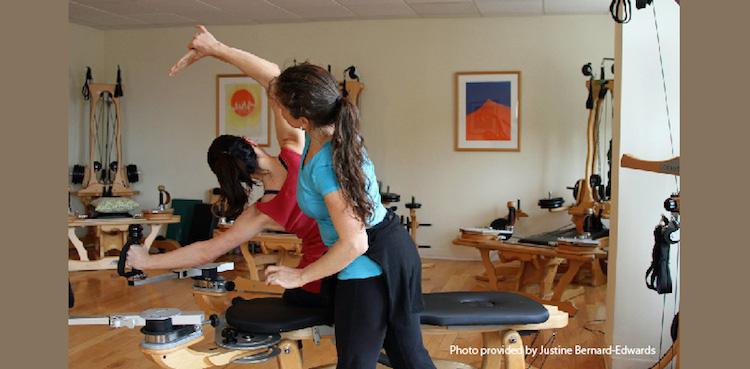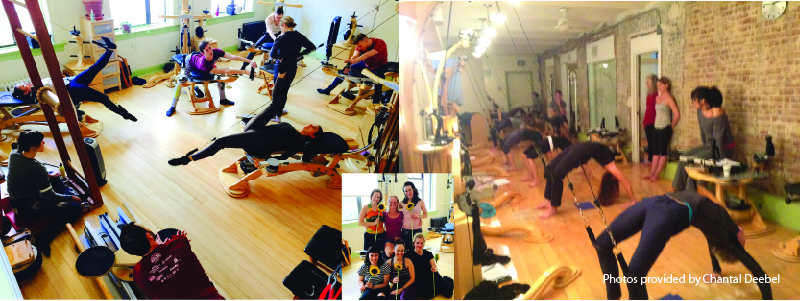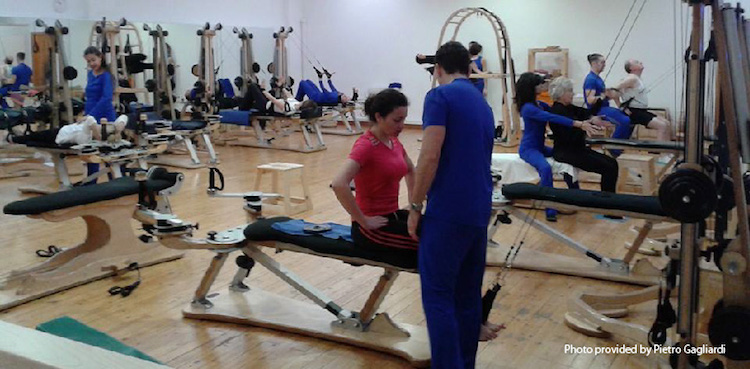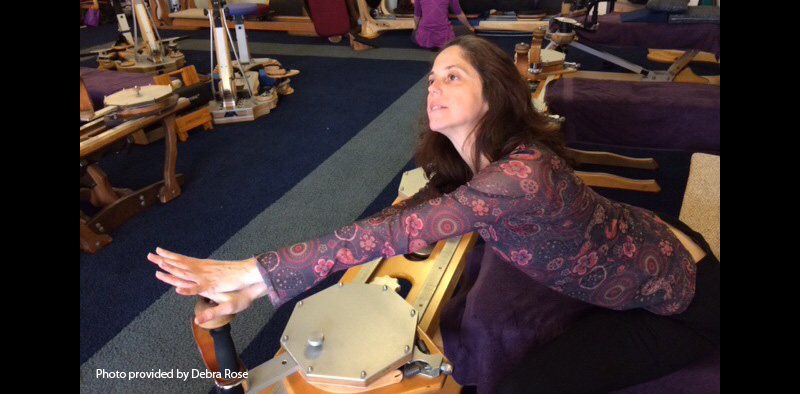Tips For Trainers, By Trainers: Creating a Successful Studio
Blog Content Tips for Trainers // September 08, 2015
Have you considered opening your own studio? Or, do you currently own and manage a studio?
The variables involved in running a studio can be exciting… and also overwhelming. So we’ve asked a few successful studio owners for tips on how they approach such a venture.

JUSTINE BERNARD
GYROTONIC® Master Trainer and GYROKINESIS® Trainer
Owner, Elements Fitness and Wellness Center
http://www.elementscenter.com/
What is your definition of a successful studio?
The answer depends on your definition of success. To be successful, I recommend you first decide what success would look like to you.
For me, I wanted a studio where I could collaborate with co-workers, have flexible hours and earn a regular salary consistent with my degrees and experience. It took me 5 years to achieve these goals.
How do you get new clients?
The best way to get new clients… referrals!
Since the GYROTONIC® Method doesn’t yet have name recognition, word-of-mouth is the best form of marketing.
1. Establish relationships with like-minded people to cross-refer clients. Find high quality chiropractors, massage therapists or other body workers to cross-refer clients.
Just yesterday a new client was referred by her massage therapist because she has seen “bodies change with Gyrotonic exercise.” In this case, I followed up with the massage therapist and thanked her for the referral.
2. Thank your clients for referring. The best referral source is your current clients. I’ve found it’s not necessary to give free sessions or gifts for referring. Your deepest thanks and appreciation goes a long way!
How do you deal with the stress of owning a business?
Find support! Some days you will need it! I’ve found a group of women small-business owners, as well as a few Gyrotonic studio owners, to discuss issues that arise.
One of “my peeps” is a woman who owns a yoga studio that specializes in classes for parents and kids. If I get a lead or email that may help her, I forward it to her, and she does the same for me. We support each other in times of emotional and mental stress, as well as with business leads and ideas.
You can also use your support-people for accountability; if you set business goals they can check and make sure you are reaching your goals.
How do you create a good working environment?
A wonderful working environment is essential to success, so love where you work and find people you enjoy working with.
This takes time. It seems all business owners have their stories of a staff member or two who was a “Debbie Downer” or “energy sucker” or “needy princess,” etc. When building your team, be selective, check references and backgrounds. Decide what you value and make sure they are on board. I no longer hire everyone I meet. I decide if this is someone I want in my life as part of the team.
I now have the best team I’ve ever had and it took me seven years to find them all! And as one of my mentors told me, “Never bite the hand that feeds you.” Take good care of your teachers and support staff.
How do you find time to run the business?
Balancing teaching-time, business-time and me-time is an important part of owning a successful studio. I see business owners teaching all day and then staying at the studio all hours of the night to run the company. They are fried and burned out!
It’s important to set aside time to run the business. I do my best to set aside a certain day for each task. I update the website on the 15th of every month. I meet with the bookkeeper once every 6 weeks. I do marketing every Friday, answer lengthy emails and chart on Wednesday, and block out time to work out everyday even if it’s only 15 minutes. For me, this means I do the GYROTONIC® Method on Tuesday and Thursday mornings and cardio on Friday evenings.
By breaking everything down, I don’t get distracted and try to accomplish it all in one day.
What do you typically delegate?
If you value yourself, you will delegate. Ask yourself what you like to do and delegate the rest. In other words, decide what you enjoy and what you don’t.
I don’t enjoy administrative work, so I hired a wonderful manager to take care of it. Sometimes I enjoy marketing and sometimes I don’t, so over the past eight years I’ve hired part-time assistance for this when needed. Figure out your own value. Often you are worth more teaching or drumming up new business, instead of working at the desk. For example, after two years I grew too big to deal with the books myself; it was too time-consuming, and I am more valuable to the studio as a teacher then a bookkeeper.

CHANTAL DEEBLE
GYROTONIC® and GYRONKINESIS® Master Trainer
Owner, Kinespirit Riverside and Kinespirit Circle
http://kinespirit.com/
What is your definition of a successful studio?
A successful studio cultivates an environment in which you build community. The clients, the teachers, and admin staff become the fabric of that community.
The decision to open a studio may at first seem like an obvious way to create a place where you can do the work you love – teach! But operating a successful studio ultimately requires you to broaden this interest, because there are myriad aspects to overseeing a successful studio — minutiae!
What do you look for when hiring people?
Take a keen interest in populating your studio with like-minded people who are also passionate about what your studio offers. The teachers you hire, and the admin who support the studio’s teachers and clients all become the team that makes your studio hum.
How do you set and manage expectations for your team and clients?
With clear and transparent communication. When bringing someone into the fold, communicate clearly what the expectations are. Taking the time to outline how your studio operates means expectations are managed.
This same approach holds true when welcoming new clients. Make them as comfortable and familiar with your studio and how you operate as soon as possible. The sooner they feel part of the community, the better.
What creates a good studio experience?
Understand the experience your studio provides to your clients, and ensure that the goal of all involved (teachers, admin) is to provide each client the best experience possible every time they visit.
In addition, maintain open communication. Make yourself available to your staff and client-base, so they feel you are approachable whenever an issue may arise.
Why is it important to keep up your own practice?
Our studios are people-driven! What we provide our clients is joy in the form of movement.
Keeping up our own practice, our own joy of movement in our own bodies, and sharing that with our studio-community in an authentic way (e.g. teaching clients, classes, courses, workshops, offering staff workouts, etc.) will keep the fabric of your community weaving, spiraling and successfully growing.

PIETRO GAGLIARDI
GYROTONIC® and GYROKINESIS® Master Trainer
Owner, White Cloud Studio
http://whitecloudstudio-roma.com/eng/home.cfm?id_menu11=1
The White Cloud Studio Roma was founded in 1997 with the aspiration of being the place where people can realize completeness, starting with learning how to take care of their own physical well-being.
The White Cloud Studio was the first Gyrotonic studio offering teacher training in Italy and is the largest Gyrotonic studio in the world.
From its inception, the studio has grown to see enormous success. The activity and the number of Gyrotonic and Gyrokinesis clients has continued to increase through the years because of the professionalism of the trainers and the validity of the Gyrotonic and Gyrokinesis Methods. The Methods are gaining increased interested from the medical community.
Today the White Cloud Studio has 50 trainers working in three studios, located in different areas of Rome, and working with almost 400 clients per week.
Besides the Gyrotonic Method, the Rome studio collaborates with many qualified professionals in various therapeutic disciplines for the purpose of helping people achieve better psycho-physical balance.
When I opened the studio, I made a promise to myself, both as a man and an artist, that this studio would promote talent and excellence in normal life and in artistic life. In 2011 the studio became the base for the WHITE CLOUD OPERA, an ensemble of talented artists that are all also Gyrotonic Trainers. The studio has become a place for them to feel free to express themselves and gain energy and inspiration in harmony with the spirit of the Gyrotonic Method.
I hope that everyone who enters into this studio can ‘vibrate their own soul.” May the encounter they have with people here create a sense of harmony and a rising appreciation for the beauty and the simplicity of life.

JESSICA GOWEN
GYROTONIC® Master Trainer and GYROKINESIS® Trainer
Owner, CORE Buckhead
www.coreatl.com
5 Keys to Running a Successful Studio
In October, 10 years will have passed since CORE took shape on paper during a late evening conversation at a Starbucks. When Emily Smith and I sketched out the studio we envisioned, we knew we wanted to run our business well, but we had no formal training to know exactly what skills were needed to make that happen. Our industry has come a long way in the last decade, with seasoned business owners running successful studios around the country. Now, as was the case a decade ago, running a studio requires more than being a great instructor and relationship builder. Running a studio successfully requires a solid business skill set. Fortunately, we now have a generation of studio owners who can lay the groundwork for a more professional and sustainable industry. The tips below are among the largest lessons learned thus far along my entrepreneurial path.
Identify the values that drive you. Make them the foundation of your studio culture and build a team that shares them. They are your road map, and when the map is unclear, they are your compass for finding your way. When you are clear on your values and hire (and fire) accordingly, the odds of your team functioning well – even in times of conflict or economic stress – are significantly higher.
Learn the basics of financial management. Understanding the information in and the relationships between your income statement, balance sheet and statement of cash flows enables you to know how much cash you need on hand now and how much you need for the long run. In an industry that often relies on packages of sessions sold to be used in the future, understanding your earned and unearned revenue, your accounts receivable, and your margin on the sessions you teach can make the difference between making it through lean times or not.
Identify 5-10 key performance indicators that tell you on a weekly or monthly basis how your business is performing. This could be as simple as the number of sessions you’ve taught or as complex as your third-step conversion rate for new clients. You should be able to look at these numbers, to understand what they mean individually and collectively, and to tell the story of your business at any given time.
Seek out mentors and educational opportunities to develop your business skills. As teachers, we don’t hesitate to invest heavily or travel far and wide for another course to expand on our teaching skills. As business owners, we need to invest similarly in our capacity to work on our businesses, not just in them.
Take care of yourself. Whether it is scheduling regular workouts, taking ongoing continuing education courses, having periodic days away from your business and familial obligations, or making sure you have time with the friends and family who fill you up, determine what you need to do to stay passionate, inspired and healthy to continue to run your business for the long haul.
In the last decade, I’ve been fortunate to have a series of mentors, educational opportunities and employees willing to share their candid feedback with me. All of those factors have helped me become a business person in addition to being a teacher. I’ve read voraciously and made many, many mistakes. Along the way, I’ve simply aimed to do my best, continuously refine my skill set and learn from my mistakes to make yesterday’s best a stepping stone for future success.
Resources
The U.S. Small Business Administration (SBA) funds a network of Small Business Development Centers that offer low-cost (and even free) ongoing education programs for current and aspiring entrepreneurs. Our tax dollars fund the SBDC network, so take advantage of something you are already paying for!
Vistage is a membership-based executive coaching and leadership training organization that operates local groups of 10-15 entrepreneurs and business leaders for ongoing education and support. While Vistage (and similar peer education organizations) is a significant investment, it can provide substantial education and support for a developing entrepreneur.
The Goldman Sachs 10,000 Small Businesses Program (www.10ksb.org) and FastTrac (www.fasttrac.org) are two of many courses that offer entrepreneurs an intensive foundation in business education without an MBA.
Books
The E-Myth, Michael Gerber
Tribal Leadership: Leveraging Natural Groups to Build a Thriving Organization, Dave Logan
Financial Intelligence: A Manager’s Guide to Knowing What the Numbers Really Mean, Karen Berman
Traction: Get a Grip on Your Business, Gino Wickman
Start with Why: How Great Leaders Inspire Everyone to Take Action, Simon Sinek
 DEBRA ROSE
DEBRA ROSE
GYROTONIC® and GYROKINESIS® Master Trainer
Owner, San Francisco GYROTONIC®
www.sfgyrotonic.com
I would define a successful studio as one that works for the trainer, the client, and the studio owner. It fosters an environment in which everyone can achieve his or her goals. Trainers can execute and hone their skills as they help their clients reach their health goals. Clients can reach their goals, which can range from getting in shape, to lessening pain and healing damaged tissue, to getting back to work, to feeling free and happy in their bodies. Studio owners can provide excellent service to as many people as they comfortably can. This all needs to be financially viable for the trainer and the studio owner, and affordable for the client. So in essence, everyone’s goals are the same: feel great and pay your rent.
At my studio I have tried to maximize my streams of income with a mix of clients, courses, and school programs. I have designated office people whose focus is on facilitating the flow of these streams between the trainers and the clients/students. I try to consider the trainers, the clients and myself in all my decisions. I love to make things work for everyone. If we all have our cake and we all eat together, that’s a successful studio – and a nice party!
Here are some of the things that I believe need to happen to facilitate this:
- Studio owners need to give their trainers clients with whom they can successfully work.
- Trainers need to bring in clients who can come in on a regular basis.
- Trainers need to make between 50 and 75% of their clients’ fees.
- Studio owners need to make between 25 and 50% of their clients’ fees.
- Encourage everyone to acknowledge and show appreciation for each other’s piece of the puzzle. That makes your studio a place people want to come to.
As a studio owner I have been most successful at:
- Acquiring excellent trainers.
- Building a functional, inviting, and exciting environment that is also soothing.
- Creating an office that is consistently responsive, with excellent follow-through.
Excellent trainers are people persons, are team players, and are always hungry to improve their skills. They have a certain level of maturity, see the larger picture, and think beyond themselves. It’s likely they will already have used the Gyrotonic Method to heal themselves in some way, so they will understand deeply the strength and capacity the system has as a healing tool. The team at SFG is nothing less then amazing!
A great studio environment is extremely organized, efficient, well equipped, while feeling casual, fun and easy-going. Laughter and hard work go hand in hand here.
A supportive office is easy to reach by all means of communication. We answer the phones 7 days a week and respond to emails almost immediately. We keep track of all requests and are great at follow through. My office staff love their databases. We utilize a suite of software applications, such as MBO, Drop Box, Highrise and Quickbooks online. If anyone out there can help me improve on this software list in terms of efficiency and cost, I’m all ears.
When I first opened, almost 30 years ago, the main way to get clients in the door was word of mouth. I talked the system up with everyone and anyone I met. I love the work and my belief in it is palpable. Today studios utilize the Internet, whether through social media, newsletters, deals such as classpass, or just plain email. Social media tools certainly enable you to reach more people more easily. But the core concept today is the same as it was for me three decades ago: Passion and enthusiasm are contagious. Believe deeply in your product/service, and you will get more first-timers in the door. Then it’s up to you and your trainers to demonstrate the power of the Gyrotonic Method force.

I know someone who is a owner of a gym and they have a room for space for gyrotonic machines, what do they need to run a gyrotonic facility, do the owner have to take the training or can someone is running the facility take the training and how many towers shall they open up with
Hi, Wanda. Great questions. One must be a fully qualified trainer with a valid trademark license to purchase equipment for commercial use. For specialized equipment, the trainer also must be trained on the specific type if equipment she/he wants to purchase. I hope this helps. Please let me know if I can help further. You can also inquire directly to GYROTONIC® International Headquarters at info@gyrotonic.com.
I felt compelled to answer this comment from Marlene in this way——if you have been studying Gyrotonic for 10 years you would know how to spell it.
Gyro tonics requires on going training which the trainers must take so that the clients can progress. I have been doing gyro tonics for ten years and have gone to several studios. I have never been asked what level I am on and in most situations the studio has scheduled me with whom ever was available with not effort to place me with a trainer who knows the machines. Since private sessions in gyro are expensive I have wasted a good deal of time taking sessions with trainers who have background only in Level 1 and cannot offer training sessions that utilize a variety of machines and develop skill and improve. It has been a disappointing experience.
Hi, Marlene.
My apologies for the delay in responding to your comment. Apparently, I managed to miss this. I’m sorry to hear about your less-than satisfactory experiences. To your concerns, I should mention that each of our studios around the world do have trainers of varying degrees of education and expertise. My suggestion would be to contact a studio prior to your visit and asses the trainers who are available to you by asking about their particular qualifications. If you have a clear idea of what you are looking for/interested in, it may be productive to also speak to a potential instructor prior to your visit in order to discuss if you are a good fit for one another. This may help you eliminate unnecessary disappointment after arrival. Additionally, I would recommend letting your next trainer know your concerns so there is open communication about what may work and not work for you. I hope this helps, and I hope you have better experiences in the future! Please let me know if you have further questions – Cina Canada, Media Coordinator, GYROTONIC® and GYROKINESIS® International Headquarters